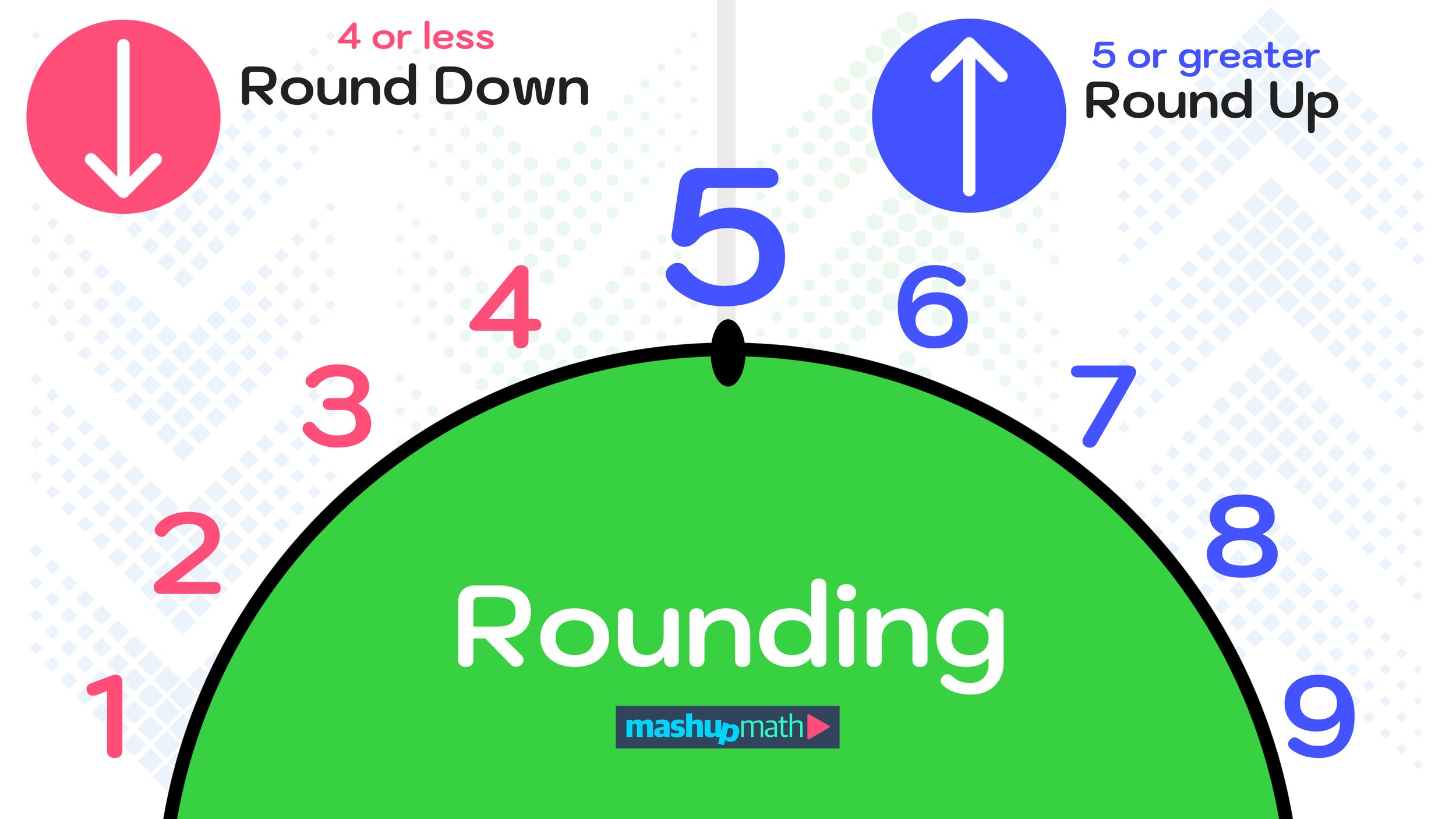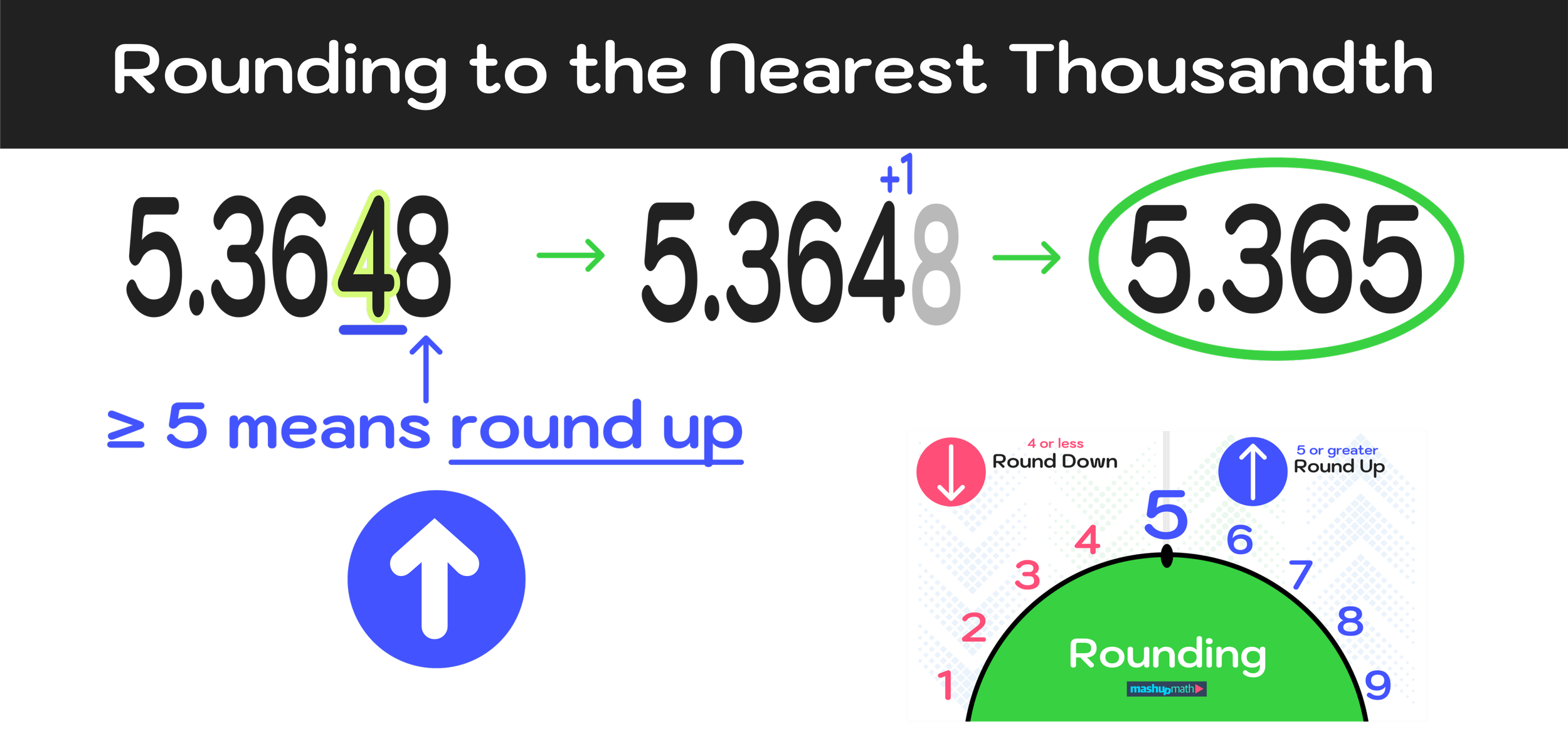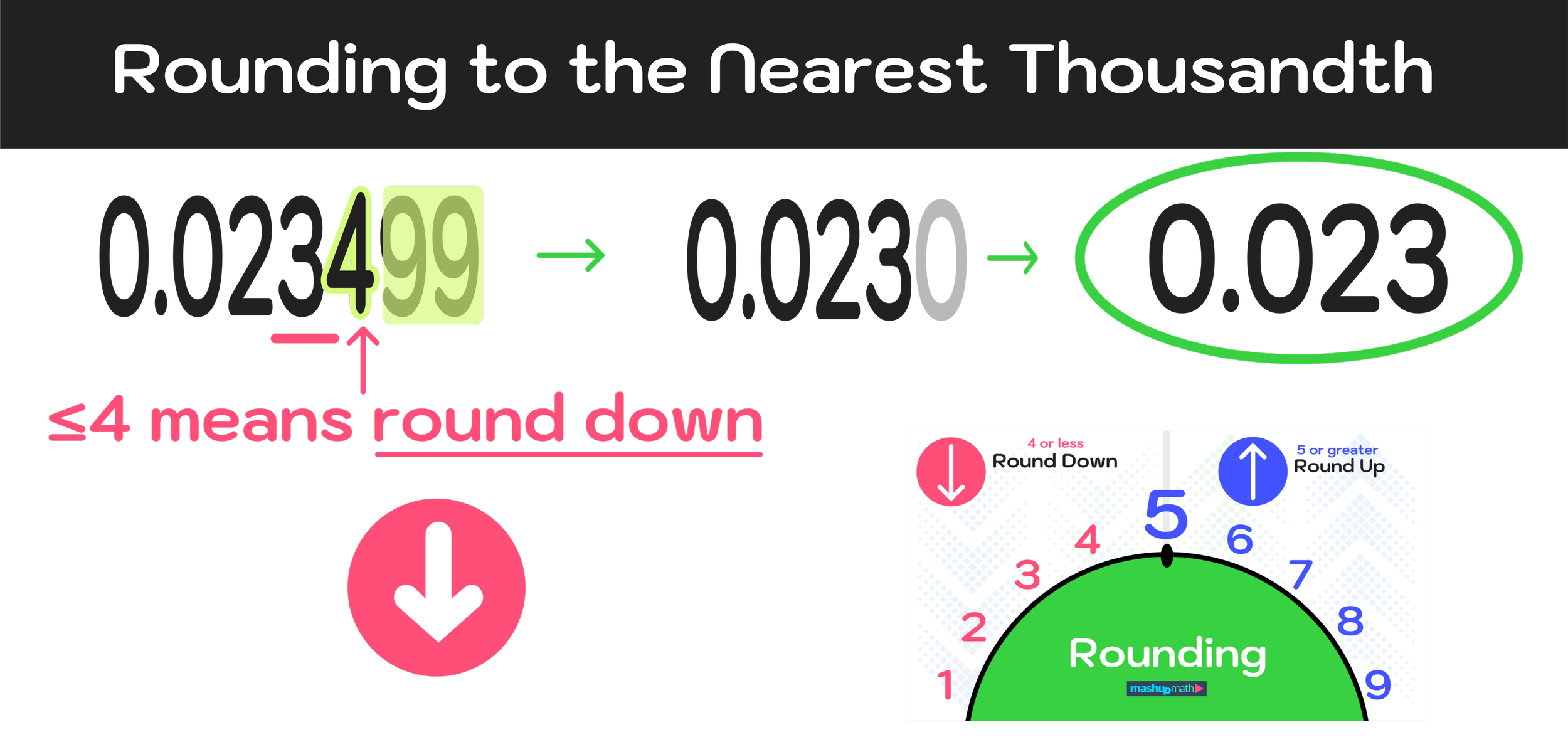How to Round to the Nearest Thousandth
Rounding to the Nearest Thousandth in 3 Easy Steps
Learning how to correctly round numbers, especially numbers with decimals, is an important math skill that will help you to work with numbers, make accurate estimations, and solve problems.
Many students find rounding to be a relatively easy skill to learn when it comes to working with whole numbers, but many of those same students will struggle with rounding once decimals are involved. However, while rounding decimal numbers may seem trickier than rounding whole numbers, the process remains the same and learning how to round to the nearest thousandth decimal place is a math skill that every student can easily learn.
Ready to learn how to round to the nearest thousandth? This free step-by-step guide will show you how to round to the nearest thousandth by working through six different practice problems together. By working through each problem together, you will gradually learn everything you need to know about rounding to the nearest thousandth to the point that you will be able to solve decimal rounding problems with ease.
For this guide on rounding, you can work through each section in order, or you can use the quick links below to jump to a particular section of interest:
(Looking for help with rounding to the nearest tenth and rounding to the nearest hundredth?)
What is Rounding?
In math, the process of rounding involves taking a given number and rewriting it as a new number that serves as a close estimation of its actual value. Why? Because, mathematically speaking, doing so makes the original number easier to work with.
Consider a smoothie that costs $7.95. By rounding to the nearest whole number (or whole dollar in this case), you could say that the cost of a smoothie is $8. If you had to figure out the cost of 13 smoothies, without rounding, you would have to calculate 7.95 x 13 = ?, which isn’t exactly the easiest multiplication problem to solve in your head. On the other hand, if had to figure out the cost of 13 smoothies after rounding $7.95 to $8, you can determine close estimate of the actual cost simply by performing 8 x 13 = $104. So, you could say that the approximate cos of 13 smoothies would be $104.
Actual Cost: 7.95 x 13 = $103.35
Estimated Cost: 8.00 x 13 = $104.00
Notice how rounding made this problem much easier to solve and the difference between the actual cost and the estimated cost is relatively small.
The key takeaway here is that rounding a mathematical tool that you can use to estimate values and make them easier to work with and perform operations on.
Figure 01: The process of rounding involves taking a given number and rewriting it as a new number that serves as a close estimation of its actual value
Rounding Up vs. Rounding Down
Next, let’s run through a quick refresher on the difference between rounding up and rounding down.
You probably already know that, when it comes to rounding, the number 5 is a big deal. Why?
Rounding Rule: If the number directly to the right of the number you are rounding is greater than or equal to 5, then you will round up. Conversely, if the number directly to the right of the number you are rounding is less than or equal to 4, then you will round down.
As far as rounding rules go, this is the only true definition that you will need to remember if you want to learn how to successful round to the nearest thousandth. And, this rule will apply to any rounding problem you will come across, so make sure that you have a firm understanding of it before moving on.
Reminder:
If the number directly to the right of the number you are rounding is ≥ 5 → round up
If the number directly to the right of the number you are rounding is ≤ 4 → round down
Let’s consider two simple examples:
Example A: Round 128 to the nearest ten.
In this example, 2 is in the tens decimal place and the number 8 is directly to the right of it. Since 8 ≥ 5, you will have to round up the 2 as follows:
128 → 130
Example B: Round 254 to the nearest ten.
In this example, 5 is in the tens decimal place and the number 4 is directly to the right of it. Since 4 ≤ 4, you will have to round down the 5 as follows:
254 → 250
Figure 02: Whenever the number directly to the right of the number you are rounding is ≥ 5, you have to round up. Otherwise, round down.
3-Step Process: How to Round to the Nearest Thousandth
Now that you understand what it means to round a number and the difference between rounding up and rounding down, you are ready to learn how to round to the nearest thousandth and work through some practice problems.
For all of the rounding to the nearest thousandth examples in this guide, we will be using the following 3-step process for rounding to the nearest thousandth:
Step #1: Locate and underline the value in the thousandths place value slot
Step #2: Identify if the number directly to the right is ≥ 5 or ≤ 4
Step #3: If the number directly to the right is ≥ 5, round up the number in the thousandths place value slot. If the number directly to the right is ≤ 4, round down the number in the thousandths place value slot to zero.
It’s ok if this 3-step process seems complicated at first glance. After working through a few examples, you will become much more comfortable with using these three steps to solve decimal rounding problems with ease
Example #1: Round to the Nearest Thousandth: 5.3641
Let’s go ahead and dive into our first example where we are tasked with rounding 5.3641 to the nearest thousandth.
We will solve this problem (and all of the practice problems in this guide) using the previously described 3-step process as follows:
Step #1: Locate and underline the value in the thousandths place value slot
For the number 5.3641, there are four numbers to the right of the decimal place. The third number to the right of the decimal place will always be the thousandths place value slot, which, in this example, is the number 4.
Locating and underlining the value in the thousandths place vale slot is illustrated in Figure 03 below.
Figure 03: How to round to the nearest thousandth: The first step is to identify the thousandths place value slot.
Step #2: Identify if the number directly to the right is ≥ 5 or ≤ 4
Next, take a look at the number directly to the right of the 4 in the thousandths place value slot.
In this example, that number is 1, which is ≤ 4.
Step #3: If the number directly to the right is ≥ 5, round up the number in the thousandths place value slot. If the number directly to the right is ≤ 4, round down the number in the thousandths place value slot to zero.
Since the number directly to the right of the 4 in the thousandths place value slot is 1, which is ≤ 4, you will have to round down.
In this case, rounding down means that the 1 to the right of the 4 in the thousandths place value slot becomes a zero and effectively disappears, which leaves us with:
Final Answer: 5.3641 rounded to the nearest thousandth is 5.364
The complete process of solving this first example is shown in Figure 04 below:
Figure 04: When rounding down, the number to the right of the thousandths decimal slot becomes a zero and disappears.
Example #2: Round to the Nearest Thousandth: 5.3648
For the next example, you will notice that the number in question is very similar to the previous example. In this case, the only difference is that the final number is an 8 rather than a 1.
How will this difference effect the final answer? Let’s apply our 3-step process and see:
Step #1: Locate and underline the value in the thousandths place value slot
For this example, the number 4 is in the thousandths place value slot as shown in Figure 05 below.
Figure 05: How to round to the nearest thousandth: Start by identifying the value in the thousandths decimal slot.
Step #2: Identify if the number directly to the right is ≥ 5 or ≤ 4
In this example, the number directly to the right of the 4 in the thousandths place value slot is 8.
Step #3: If the number directly to the right is ≥ 5, round up the number in the thousandths place value slot. If the number directly to the right is ≤ 4, round down the number in the thousandths place value slot to zero.
The number directly to the right of the 4 in the thousandths place value slot is 8, and 8≥ 5, so this time we will be rounding up.
When rounding up, you will add one to the value in the thousandths place value slot (4 in this example) and all numbers to the right of it will disappear.
Final Answer: 5.3648 rounded to the nearest thousandth is 5.365
This process of solving Example #2 is illustrated in Figure 06 below.
Figure 06: 5.3648 rounded to the nearest thousandth is 5.365
Before moving onto more practice problems, let’s take a closer look at the differences between rounding the numbers in Example #1 and Example #2 to the nearest thousandth:
Example #1: 5.3641 → 5.364 (we rounded down)
Example #2: 5.3648 → 5.365 (we rounded up)
The graphic in Figure 07 below further highlights the differences between how we solved these first two examples (namely, the difference between solving by rounding down and solving by rounding up).
Figure 07: Examples of rounding down vs. rounding up.
Example #3: Round to the Nearest Thousandth: 1.27025
Moving onto this next example, you will notice that the number 1.27025 includes five digits to the right of the decimal point. However, whenever you are rounding to the nearest thousandth, you will only need to first four digits and anything beyond that can be ignored.
To see this process in action, let’s go ahead and apply our 3-step process for rounding to the nearest thousandth.
Step #1: Locate and underline the value in the thousandths place value slot
For the number 1.27025, the number 0 is in the thousandths place value slot, as shown in Figure 08 below.
Figure 08: Remember that you only need the first four digits the right of the decimal point to round a number to the nearest thousandth. Anything beyond that can be ignored.
Step #2: Identify if the number directly to the right is ≥ 5 or ≤ 4
Next, notice that 0 is in the thousandths place value slot and the number directly to the right of it is a 2, which is ≤ 4.
Step #3: If the number directly to the right is ≥ 5, round up the number in the thousandths place value slot. If the number directly to the right is ≤ 4, round down the number in the thousandths place value slot to zero.
Since 2 ≤ 4, we will be rounding down to solve this problem as is shown in Figure 09 below:
Final Answer: 1.27025 rounded to the nearest thousandth is 1.270
Figure 09: 1.27025 rounded to the nearest thousandth is 1.270
Example #4: Round to the Nearest Thousandth: 24.3759414
Again, we can solve this problem by applying our 3-step process. Just remember that you can ignore any numbers that come after the fourth number to the right of the decimal point.
Step #1: Locate and underline the value in the thousandths place value slot
For the number 24.3759414, the number 5 is in the thousandths place value slot.
Figure 10: The number 5 is in the thousandths place value slot.
Step #2: Identify if the number directly to the right is ≥ 5 or ≤ 4
The number directly to the right of the 5 is 9, and 9 ≥ 5.
Step #3: If the number directly to the right is ≥ 5, round up the number in the thousandths place value slot. If the number directly to the right is ≤ 4, round down the number in the thousandths place value slot to zero.
Since 9 ≥ 5, you must round it up to solve this problem and conclude that:
Final Answer: 24.3759414 rounded to the nearest thousandth is 24.376
Figure 11 below illustrates the entire 3-step process for rounding Example #4 to the nearest thousandth.
Figure 11: 24.3759414 rounded to the nearest thousandth is 24.376
Example #5: Round to the Nearest Thousandth: 18.34951
Are you starting to get the hang of it? Let’s continue onto another example.
Step #1: Locate and underline the value in the thousandths place value slot
For the number 18.34951, the digit in the thousandths place value slot is 9.
Figure 14: How to Round to the nearest Thousandth: The digit in the thousandths place value slot is 9.
Step #2: Identify if the number directly to the right is ≥ 5 or ≤ 4
Next, the number directly to the right is 5, and 5 ≥ 5.
Step #3: If the number directly to the right is ≥ 5, round up the number in the thousandths place value slot. If the number directly to the right is ≤ 4, round down the number in the thousandths place value slot to zero.
Since 5 ≥ 5, we know that we have to take the 9 in the thousandths place value slot and round it up. But how do you round up the number 9 without turning it into a 10?
Rule: Whenever you are rounding up the number 9, you have to turn it into a zero and add one to the number directly to the left of the 9.
Figure 13 below illustrates the application of this rule being used to solve Example #5.
Final Answer: 18.34951 rounded to the nearest thousandth equals 18.350
Figure 13: Whenever you are rounding up the number 9, you have to turn it into a zero and add one to the number directly to the left of the 9.
Example #6: Round to the Nearest Thousandth: 0.023499
You made it to the final example! To solve this last problem, we will again rely on our 3-step process as follows:
Step #1: Locate and underline the value in the thousandths place value slot
In this example, 0.023499, the number 3 is in the thousandths place value slot.
Figure 14: Reminder: When it comes to rounding to the nearest thousandth, you can ignore any additional numbers after the fourth digit to the right of the decimal point.
Step #2: Identify if the number directly to the right is ≥ 5 or ≤ 4
Notice that the number directly to the right of the 3 is a 4.
Step #3: If the number directly to the right is ≥ 5, round up the number in the thousandths place value slot. If the number directly to the right is ≤ 4, round down the number in the thousandths place value slot to zero.
Since 4 ≤ 4, we know that we have to round down to solve this problem.
Final Answer: 0.023499 rounded to the nearest thousandth is 0.023
Figure 15: Rounding 0.023499 to the nearest thousandth.
Conclusion: Round to the Nearest Thousandth
Rounding numbers, especially decimals, is an extremely important and useful math skill that helps students to estimate numbers and make calculations with them.
This guide specifically focused on rounding to the nearest thousandth, where you learned and applied a simple 3-step method to rounding any number to the nearest thousandth decimal place:
Step #1: Locate and underline the value in the thousandths place value slot
Step #2: Identify if the number directly to the right is ≥ 5 or ≤ 4
Step #3: If the number directly to the right is ≥ 5, round up the number in the thousandths place value slot. If the number directly to the right is ≤ 4, round down the number in the thousandths place value slot to zero.
You can use this 3-step process to solve any problem where you have to round a given number to the nearest thousandth! So, it should be no surprise that we were able to use it to solve all six practice problems in this guide and make the following conclusions:
5.3641 → 5.364
5.3648 → 5.365
1.27025 → 1.270
24.3759414 → 24.376
18.34951 → 18.350
0.023499 → 0.023
Need some extra practice? If so, we strongly recommend that you go back and work through the practice problems in this guide again. The more that you practice, the more comfortable you will become with the 3-step process. And, if you need some additional practice beyond this guide, check out the free rounding worksheets and answer keys available on our free math worksheet libraries.
Keep Learning:
How to Round to the Nearest Hundredth (Step-by-Step Guide)
Continue your rounding journey by learning how to round to the nearest hundredth.


























